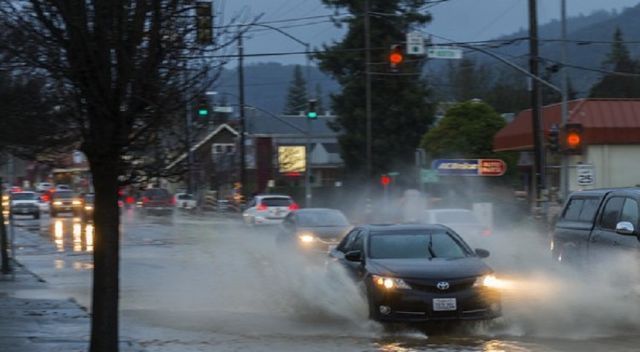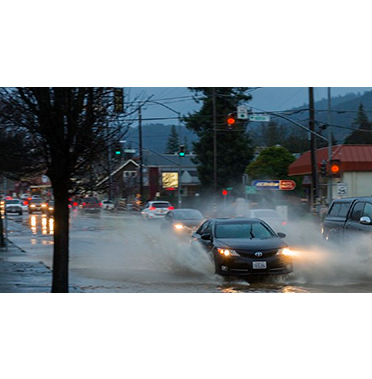About Floods
While some Californians face unprecedented droughts and water shortages, flooding is also a common hazard for many living along rivers and coastlines. According to the California Department of Water Resources, over the last 60 years, California has experienced more than 30 major flood events, resulting in lost lives and injuries and billions of dollars of damage to housing and infrastructure.
Flooding is an overflow of water that submerges areas that are usually dry. There are hundreds of water bodies in California—rivers, lakes, and miles of coastline—all of which are subject to sea-level rise.
In 2021, more than 7 million Californians, or 1 in 5, and approximately $580 billion in assets (crops, structures, and public infrastructure) are exposed to flooding. This estimate does not include the impacts of future development, population changes, climate change, or costs due to loss of major infrastructure and critical facilities, as well as losses to state commerce.
Flooding in California continues to escalate due to climate change and resultant changing weather, bringing more intense rainstorms and greater sea-level rise. Excessive rainfall coupled with housing located in flood plains increases the risk of water damage and displacement to residents. Excessive rainfall on areas scarred by fire and or steep slopes exacerbates erosion rates and adversely affects water quality and nearshore marine habitats.
There are many different types of flooding depending on the location, and they can occur at different frequencies. To learn more about each type, please visit the California Department of Water Resources.
Impact on Frontline Communities

Flooding can lead to economic and health impacts from exposure to polluted water, damage to infrastructure, loss of interior finishes and household belongings, growth of toxic mold, the release of hazardous materials, and erosion of landscapes.
Flood risk is not shared equally. Low-income communities and communities of color throughout the state live in substandard housing. Furthermore, many of these communities are located in areas that are more prone to flooding. This article demonstrates the connection between redlining and flood risk in Sacramento, California.
Actions to Take
For individuals
- Use FloodFactor.com to learn the flood risk in your neighborhood.
- Sign up for emergency alerts and follow instructions from *local* officials.
- Standard homeowners’ insurance does not cover flooding. Purchase flood insurance to cover your property and recovery in the event of a flood. The Federal Emergency Management Agency offers subsidized flood insurance to all households at risk from flooding called the National Flood Insurance Program (NFIP).
- Here is a list of low-cost projects to protect your home from flooding.
- Ready.gov offers tips and tools for before, during, and after floods.
- Try to get an Elevation Certificate, a tool the NFIP uses to check that new buildings or recent remodels in historic flood plains are elevated enough to mitigate flood damage. It can help lower your premium.
- If a flood occurs, it is critical to mitigate and dry out your house immediately, or mold might develop. Use this resource for cleaning up mold: Creating a Healthy Home: A Field Guide for Clean-up of Flooded Homes by Enterprise Community Partners
For community-based organizations and affordable housing developers
- Use the strategies in Enterprise’s Business Continuity Toolkit to protect multi-family buildings from flooding and other hazards. Use the strategies in Enterprise’s Guide for Resilient Housing Design in Island Communities.
- Prioritize any upgrades to your property that will protect it against flooding.
- Partner with your local Office of Emergency Services to create a plan for your organization to be ready for a flood.
- Work with your local Office of Emergency Services to offer training to your community members on how they can be prepared for floods.
- Gather emergency supplies that you can use to support your staff and community members before, during, and after a flood. Listos California has a Disaster Ready Guide in multiple languages that can support you in setting up your emergency kits.
- Advocate for reforms to the National Flood Insurance Program (NFIP). Here’s testimony Enterprise has given to advocate for improvements to the program to protect low- and moderate-income people better.
For local and State government
- Invest money to ensure that all existing affordable housing units are retrofitted to be safe from flooding and sea-level rise. Conduct this effort in partnerships with the communities that live in the units.
- Ensure that all future housing is safe from flooding and sea-level rise. Try to avoid building more housing in flood plains. If you must build in flood-prone areas, ensure that buildings are designed to withstand high water conditions. Conduct this in partnership with community-based organizations in the areas where future housing will go.
- Work with community-based and grassroots organizations to create a plan to prepare themselves and their communities for floods.
- Participate in the Community Rating System of the National Flood Insurance Program (NFIP), which discounts your residents' premiums for implementing flood mitigation measures.
- Advocate for reforms to NFIP to protect frontline communities. Here are a few resources with suggestions on how the program can be improved:
For philanthropy
- Support community-based organizations and affordable housing owner-operators in upgrading their buildings to withstand floods.
- Fund community-based organizations to secure emergency supplies for themselves and their community members.
- Create a fund to support people who cannot afford flood insurance. This could be modeled off programs such as The Detroit Water Project, which helps people pay their utility bills.
- Advocate for reforms to NFIP. Review this testimony that Enterprise has given to improve the program.
Image: Parting the waters, Ukiah, California
Source: Bob Dass is licensed under CC BY 2.0

- Toolkit